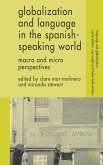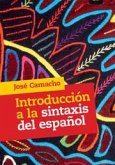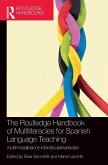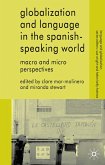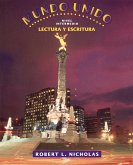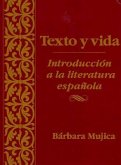- Gebundenes Buch
- Merkliste
- Auf die Merkliste
- Bewerten Bewerten
- Teilen
- Produkt teilen
- Produkterinnerung
- Produkterinnerung
Provides students with an engaging and thorough overview of the history of Spanish and its development from Latin.
Andere Kunden interessierten sich auch für
![Globalization and Language in the Spanish Speaking World Globalization and Language in the Spanish Speaking World]() Clare Mar-Molinero / Miranda StewartGlobalization and Language in the Spanish Speaking World81,99 €
Clare Mar-Molinero / Miranda StewartGlobalization and Language in the Spanish Speaking World81,99 €![Camino al español Camino al español]() Consuelo de Andrés MartínezCamino al español167,99 €
Consuelo de Andrés MartínezCamino al español167,99 €![Introducción a la Sintaxis del Español Introducción a la Sintaxis del Español]() José CamachoIntroducción a la Sintaxis del Español97,99 €
José CamachoIntroducción a la Sintaxis del Español97,99 €![The Routledge Handbook of Multiliteracies for Spanish Language Teaching The Routledge Handbook of Multiliteracies for Spanish Language Teaching]() The Routledge Handbook of Multiliteracies for Spanish Language Teaching186,99 €
The Routledge Handbook of Multiliteracies for Spanish Language Teaching186,99 €![Globalization and Language in the Spanish Speaking World Globalization and Language in the Spanish Speaking World]() Globalization and Language in the Spanish Speaking World81,99 €
Globalization and Language in the Spanish Speaking World81,99 €![Mundo Unido, Lectura Y Escritura Mundo Unido, Lectura Y Escritura]() Robert L NicholasMundo Unido, Lectura Y Escritura121,99 €
Robert L NicholasMundo Unido, Lectura Y Escritura121,99 €![Texto Y Vida Texto Y Vida]() Bárbara MujicaTexto Y Vida226,99 €
Bárbara MujicaTexto Y Vida226,99 €-
-
-
Provides students with an engaging and thorough overview of the history of Spanish and its development from Latin.
Hinweis: Dieser Artikel kann nur an eine deutsche Lieferadresse ausgeliefert werden.
Hinweis: Dieser Artikel kann nur an eine deutsche Lieferadresse ausgeliefert werden.
Produktdetails
- Produktdetails
- Verlag: Cambridge University Press
- Seitenzahl: 452
- Erscheinungstermin: 22. November 2018
- Englisch
- Abmessung: 246mm x 178mm x 25mm
- Gewicht: 1021g
- ISBN-13: 9781107144729
- ISBN-10: 1107144728
- Artikelnr.: 51153431
- Herstellerkennzeichnung
- Libri GmbH
- Europaallee 1
- 36244 Bad Hersfeld
- gpsr@libri.de
- Verlag: Cambridge University Press
- Seitenzahl: 452
- Erscheinungstermin: 22. November 2018
- Englisch
- Abmessung: 246mm x 178mm x 25mm
- Gewicht: 1021g
- ISBN-13: 9781107144729
- ISBN-10: 1107144728
- Artikelnr.: 51153431
- Herstellerkennzeichnung
- Libri GmbH
- Europaallee 1
- 36244 Bad Hersfeld
- gpsr@libri.de
Diana L. Ranson is Professor of French and Spanish at the University of Georgia. Her publications include Change and Compensation: Parallel Weakening of /s/ in Italian, French and Spanish (1989) and articles on Spanish historical linguistics, syntactic variation in Modern Spanish, and phonological variation in Modern French. She has taught the History of Spanish, the History of French, Comparative Romance Linguistics, and Old Spanish for over thirty years.
List of figures
List of maps
List of tables
Preface for students
Preface for instructors
Acknowledgments
1. Why do Spanish speakers say el arte but las artes? The value of studying the history of Spanish
2. Is it wrong to say cantastes instead of cantaste? A linguist's attitude and approach to language
3. How and why do languages change and how do linguists know?
4. Did /f/ change to /h/ in Spanish because of Basque? Four moments of language contact in the history of Spanish
5. Why is Spanish also called Castilian? The standardization process and its effects
6. How did FESTA become fiesta but FESTÎVUM became festivo? Regular vowel changes
7. How did ACÛTUM become agudo? Regular consonant changes
8. Why is 'milk' leche but 'Milky Way' is Via Láctea? Special tonic vowel changes
9. Why fieldad but lealtad? Special consonant changes
10. Why do Spanish speakers sometimes say andé instead of anduve? Morphological changes
11. Why is mano feminine and día masculine? Changes in case, declension, number, and gender
12. Why do Spanish speakers sometimes say más malo instead of peor? Origins of nominal elements
13. Why are there so many verb tenses in Spanish? Origins of verbs
14. Why is comeré the future of comer but sabré is the future of saber? How regular sound change and analogy lead to regular and irregular forms
15. Do you say veo el gato or veo al gato? Syntactic changes
16. How did MÛSC¿LUM 'little mouse' become Spanish muslo 'thigh'? Semantic changes
17. Why perro 'dog' instead of can? Lexical changes
Appendix: Selections from old Spanish texts
El Auto de los Reyes Magos
Cantar de mio Cid
Razon feita d'amor
Milagros de Nuestra Señora
Calila e Dimna
Glossary of terms
Works cited
Word index
Subject index.
List of maps
List of tables
Preface for students
Preface for instructors
Acknowledgments
1. Why do Spanish speakers say el arte but las artes? The value of studying the history of Spanish
2. Is it wrong to say cantastes instead of cantaste? A linguist's attitude and approach to language
3. How and why do languages change and how do linguists know?
4. Did /f/ change to /h/ in Spanish because of Basque? Four moments of language contact in the history of Spanish
5. Why is Spanish also called Castilian? The standardization process and its effects
6. How did FESTA become fiesta but FESTÎVUM became festivo? Regular vowel changes
7. How did ACÛTUM become agudo? Regular consonant changes
8. Why is 'milk' leche but 'Milky Way' is Via Láctea? Special tonic vowel changes
9. Why fieldad but lealtad? Special consonant changes
10. Why do Spanish speakers sometimes say andé instead of anduve? Morphological changes
11. Why is mano feminine and día masculine? Changes in case, declension, number, and gender
12. Why do Spanish speakers sometimes say más malo instead of peor? Origins of nominal elements
13. Why are there so many verb tenses in Spanish? Origins of verbs
14. Why is comeré the future of comer but sabré is the future of saber? How regular sound change and analogy lead to regular and irregular forms
15. Do you say veo el gato or veo al gato? Syntactic changes
16. How did MÛSC¿LUM 'little mouse' become Spanish muslo 'thigh'? Semantic changes
17. Why perro 'dog' instead of can? Lexical changes
Appendix: Selections from old Spanish texts
El Auto de los Reyes Magos
Cantar de mio Cid
Razon feita d'amor
Milagros de Nuestra Señora
Calila e Dimna
Glossary of terms
Works cited
Word index
Subject index.
List of figures
List of maps
List of tables
Preface for students
Preface for instructors
Acknowledgments
1. Why do Spanish speakers say el arte but las artes? The value of studying the history of Spanish
2. Is it wrong to say cantastes instead of cantaste? A linguist's attitude and approach to language
3. How and why do languages change and how do linguists know?
4. Did /f/ change to /h/ in Spanish because of Basque? Four moments of language contact in the history of Spanish
5. Why is Spanish also called Castilian? The standardization process and its effects
6. How did FESTA become fiesta but FESTÎVUM became festivo? Regular vowel changes
7. How did ACÛTUM become agudo? Regular consonant changes
8. Why is 'milk' leche but 'Milky Way' is Via Láctea? Special tonic vowel changes
9. Why fieldad but lealtad? Special consonant changes
10. Why do Spanish speakers sometimes say andé instead of anduve? Morphological changes
11. Why is mano feminine and día masculine? Changes in case, declension, number, and gender
12. Why do Spanish speakers sometimes say más malo instead of peor? Origins of nominal elements
13. Why are there so many verb tenses in Spanish? Origins of verbs
14. Why is comeré the future of comer but sabré is the future of saber? How regular sound change and analogy lead to regular and irregular forms
15. Do you say veo el gato or veo al gato? Syntactic changes
16. How did MÛSC¿LUM 'little mouse' become Spanish muslo 'thigh'? Semantic changes
17. Why perro 'dog' instead of can? Lexical changes
Appendix: Selections from old Spanish texts
El Auto de los Reyes Magos
Cantar de mio Cid
Razon feita d'amor
Milagros de Nuestra Señora
Calila e Dimna
Glossary of terms
Works cited
Word index
Subject index.
List of maps
List of tables
Preface for students
Preface for instructors
Acknowledgments
1. Why do Spanish speakers say el arte but las artes? The value of studying the history of Spanish
2. Is it wrong to say cantastes instead of cantaste? A linguist's attitude and approach to language
3. How and why do languages change and how do linguists know?
4. Did /f/ change to /h/ in Spanish because of Basque? Four moments of language contact in the history of Spanish
5. Why is Spanish also called Castilian? The standardization process and its effects
6. How did FESTA become fiesta but FESTÎVUM became festivo? Regular vowel changes
7. How did ACÛTUM become agudo? Regular consonant changes
8. Why is 'milk' leche but 'Milky Way' is Via Láctea? Special tonic vowel changes
9. Why fieldad but lealtad? Special consonant changes
10. Why do Spanish speakers sometimes say andé instead of anduve? Morphological changes
11. Why is mano feminine and día masculine? Changes in case, declension, number, and gender
12. Why do Spanish speakers sometimes say más malo instead of peor? Origins of nominal elements
13. Why are there so many verb tenses in Spanish? Origins of verbs
14. Why is comeré the future of comer but sabré is the future of saber? How regular sound change and analogy lead to regular and irregular forms
15. Do you say veo el gato or veo al gato? Syntactic changes
16. How did MÛSC¿LUM 'little mouse' become Spanish muslo 'thigh'? Semantic changes
17. Why perro 'dog' instead of can? Lexical changes
Appendix: Selections from old Spanish texts
El Auto de los Reyes Magos
Cantar de mio Cid
Razon feita d'amor
Milagros de Nuestra Señora
Calila e Dimna
Glossary of terms
Works cited
Word index
Subject index.


